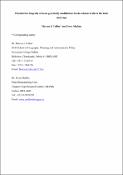Options
Potential for longevity of novel genetically modified herbicide-tolerant traits in the Irish landscape
Author(s)
Date Issued
2013-03-15
Date Available
2014-09-16T03:00:09Z
Abstract
With the renewed interest in
GM crop technology in Ireland, some concern has been raised in relation to the
potential impact on biodiversity in the Irish agri-environment. This concern
can focus on the potential for a transgenic trait to cross to wild relatives. A
novel trait will be judged to have persisted in a wild population via the
successful production of seeds, such that these seeds are viable and result in
the establishment of a self-sustaining population. In the case of a herbicide
tolerant (HT) trait, feral and volunteer populations can only remain viable if
managed with applications of the herbicide that the trait is designed to
resist. This surviving population of HT plants would then need to compete
successfully with other wild plants in order to prevail in the landscape and
persist over time. There are few agricultural crops that can manage this
combination, but as oilseed rape plants are often noted along roadsides and
hedgerows in Ireland, it is correct to assume that this crop has the ability to
be a successful feral survivor. This paper presents the results of a thought
experiment, derived exclusively using the academic literature, on the issue of
longevity. This is done by taking four hypothetical case scenarios and
examining the potential for a combination of events to take place for oilseed
rape (Brassica napus), selected here
because it has a high potential for 'escaping' via pollen- and/or seed-mediated
gene flow. A lack of quantitative data on Irish farmland biodiversity hinders
solid conclusions, but when management pressure is eased biodiversity stress is
lessened.
GM crop technology in Ireland, some concern has been raised in relation to the
potential impact on biodiversity in the Irish agri-environment. This concern
can focus on the potential for a transgenic trait to cross to wild relatives. A
novel trait will be judged to have persisted in a wild population via the
successful production of seeds, such that these seeds are viable and result in
the establishment of a self-sustaining population. In the case of a herbicide
tolerant (HT) trait, feral and volunteer populations can only remain viable if
managed with applications of the herbicide that the trait is designed to
resist. This surviving population of HT plants would then need to compete
successfully with other wild plants in order to prevail in the landscape and
persist over time. There are few agricultural crops that can manage this
combination, but as oilseed rape plants are often noted along roadsides and
hedgerows in Ireland, it is correct to assume that this crop has the ability to
be a successful feral survivor. This paper presents the results of a thought
experiment, derived exclusively using the academic literature, on the issue of
longevity. This is done by taking four hypothetical case scenarios and
examining the potential for a combination of events to take place for oilseed
rape (Brassica napus), selected here
because it has a high potential for 'escaping' via pollen- and/or seed-mediated
gene flow. A lack of quantitative data on Irish farmland biodiversity hinders
solid conclusions, but when management pressure is eased biodiversity stress is
lessened.
Other Sponsorship
EPA STRIVE
Teagasc
Type of Material
Journal Article
Publisher
Taylor & Francis (Routledge)
Journal
Irish Geography
Volume
45
Issue
2
Start Page
117
End Page
130
Copyright (Published Version)
2013 Geographical Society of Ireland
Language
English
Status of Item
Not peer reviewed
ISSN
1939-4055
This item is made available under a Creative Commons License
File(s)
Loading...
Name
COLLIER_AND_MULLINS_2013_IrGeo.pdf
Size
349.94 KB
Format
Adobe PDF
Checksum (MD5)
d27e695ec85be5df4763259a977ca79a
Owning collection